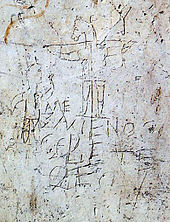Onolatry
 From Wikipedia the free encyclopedia
From Wikipedia the free encyclopedia

Onolatry is the supposed worship of the donkey. In Imperial Rome, the charge of onolatry was used to taunt the Jews and Jewish Christians.[1] The association of Jews with donkeys was a common feature of Hellenic as well as Latin ethnographic and historical writings, and included accusations of worshipping a golden donkey head and even sacrificing foreigners to it at intervals.[2] A famous example of this is the Alexamenos graffito.[3]
The charge was likely first used against Jews in Egypt, where donkeys were at some points associated with Set, the murderer of Osiris who is in turn destroyed by Isis.[4] It is first attested in the late first century BCE, and was used against Christians extensively in the first and second centuries CE before disappearing almost entirely in the third.[5] The accusation against the Christians is discussed by Tertullian and Minucius Felix, among other early Christian apologists.[6]
Arthur Bernard Cook, in an 1894 article, argued that there had been an ancient Mycenaean cult practising onolatry, citing a fresco depicting donkey-headed figures found near a sacrificial pit and several carved gems apparently showing people wearing donkeys' heads and skins holding sacrificial objects, and further describing the diverse roles asses played in Ancient Greek mythology.[7] His interpretation was challenged at the time by Andrew Lang in Longman's Magazine.[8]
See also
[edit]References
[edit]- ^ Gavrilyuk, Paul L. (2004). The Suffering of the Impassible God. Oxford University Press. p. 76. ISBN 978-0-19-926982-2. Retrieved 14 October 2008.
- ^ Wellman, T. J. (2008). "Making Tradition of an Ass. Zênôn the Alexandrian, a White Donkey, and Conversion to Hellenism". Religion and Theology. 15 (3): 321–339. doi:10.1163/157430108X376564.
- ^ Herbermann, Charles George (1907). The Catholic Encyclopedia. The Encyclopedia Press. p. 793. Retrieved 14 October 2008.
- ^ Cueva, E.P.; Byrne, S.N. (2014). A Companion to the Ancient Novel. Blackwell Companions to the Ancient World. Wiley. p. 183. ISBN 978-1-4443-3602-3. Retrieved 11 July 2018.
- ^ Ramelli, Ilaria (2013). "Apuleius and Christianity: The Novelist-Philosopher in front of a New Religion". In Pinheiro, M.P.F.; Bierl, A.; Beck, R. (eds.). Echoes of Myth, Religion and Ritual in the Ancient Novel. De Gruyter. p. 148. ISBN 978-3-11-031190-7.
- ^ Hassett, M. (1907). "The Ass (in Caricature of Christian Beliefs and Practices)". The Catholic Encyclopedia. Robert Appleton Company.
- ^ A.B. Cook (1894). "Animal Worship in the Mycenaean Age". The Journal of Hellenic Studies. 14: 81–169. doi:10.2307/623962. JSTOR 623962. S2CID 162848452.
- ^ "At the Sign of the Ship". Longman's Magazine. Vol. 24. 1894. p. 546. Retrieved 11 July 2018.
External links
[edit]- (in Italian) Tiberio..., of Zvi Yavetz, on books.google.it